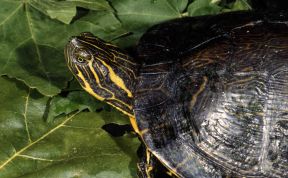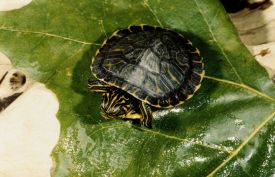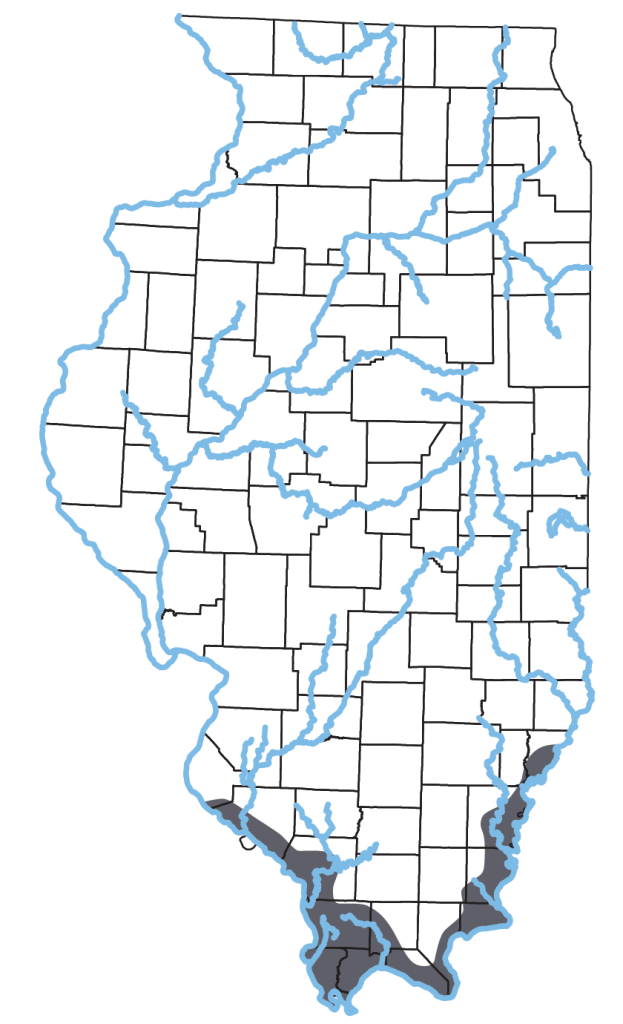Pseudemys concinna (LeConte, 1830)


Key Characteristics: Intricately patterned carapace; unpatterned or sparsely patterned plastron; no red head stripe; no dark smudges on plastral scutes.
Similar Species: Red-eared Slider. See Key to Adult Turtles of Illinois for help with identification.
Subspecies: Smith (1961) considered all Illinois populations to be hybrids between P. c. hieroglyphica (Holbrook, 1836) and P. floridana hoyi (Agassiz, 1857). The current understanding is that there are only two valid subspecies; Eastern River Cooter, P. c. concinna and Coastal Plain Cooter, P. c. floridana (LeConte, 1830). All Illinois populations are Eastern River Cooters.
Description: Large (up to 32 cm CL) turtle with striped head. Adult carapace olive to dark brown, patterned with yellow or orange lines or swirls, flared posteriorly, and without keel along the back. Male with elongate foreclaws and vent behind end of carapace.
Habitat: Backwaters and oxbow lakes of large rivers and reservoirs.
Natural History: Basks regularly, but wary and difficult to approach. Young are omnivorous, adults are chiefly herbivorous. Courting male swims with and above female, vibrating foreclaws in her face. Female digs nest in soil during late spring and lays up to 20 ellipsoidal eggs (ca. 35 x 25 mm), usually more than once annually. Hatchlings emerge August-September, or overwinter in nest.
Distribution Notes: The Jersey County records are two DOR specimens observed in 1981, but no museum specimens are extant. It is doubtful that the species occurs that far north in the Mississippi River. Populations persist along lower Wabash and Ohio rivers.
Status: State endangered. Threats include pollution, drainage of backwaters, and flood control projects that isolate backwaters from rivers.
Etymology: Pseudemys– pseudos (Greek) meaning lie; emys (Greek) for ‘freshwater tortoise’; concinna – concinnus (Latin) meaning well-arranged, skillfully joined.
Original Description: LeConte, J. 1830. Description of North American tortoises. Annals of the Lyceum of Natural History of New York.
Type Specimen: Not designated, but there are several specimens in the MNHN that were donated by LeConte and may be part of his type specimens.
Type Locality: “inhabits rivers of Georgia and Carolina, where the beds are rocky. I have never seen them below Augusta on the Savannah, or Columbia on the Conagree”. Restricted to the vicinity of Columbia, South Carolina by Schmidt (1953).
Original Name: Testudo concinna LeConte, 1830
Nomenclatural History: Smith’s treatment of this species’ nomenclature is discussed above. Davis & Rice (1883. List of Batrachia and Reptilia of Illinois. Bulletin of the Chicago Academy of Sciences. vol. 1, no. 3) used the name Pseudemys hieroglyphica in their Illinois list. Several other names have been applied to this species in Illinois including Chrysemys hieroglyphica, Chrysemys concinna, and Pseudemys labyrinthica.


